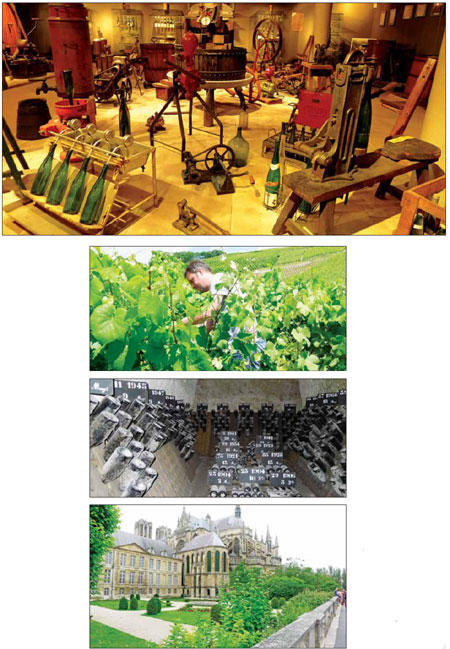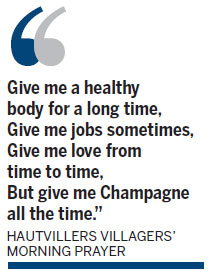
 |
|
From top: A small museum showcases traditional wine making tools in Alsace. Winery owner Jean-Baptiste Geoffroy works in his vineyard in Reims. The arched cellars of Champagne Pommery in Epernay store more than 20 million bottles. Notre-Dame de Reims is a World Heritage site. Photos by Mao Ning / China Daily |

A tour of the Alsace and Champagne wine routes naturally provides wines to sample and plenty of food for thought, Mao Ning discovers.
France is best known for being the home of luxury goods and Paris, but a wine tour offers unrivaled scenery and valuable cultural insights. As part of "Experience France with Wine Tours", a three-year program rolled out by the French Ministry of Agriculture, to acquaint more Chinese visitors with France's wine culture, I joined a small group of reporters touring the Alsace and Champagne wine routes.
We set out from Colmar, a small city some 70 km southwest of Strasbourg, capital of France's Alsace province, which borders Germany and Switzerland.
A border region, France and Germany have fought over it for centuries. As a result, it has inherited and blended both cultures to create its own unique architectural style, cuisine and language.
Our arrival in tranquil and picturesque Colmar was like stepping into the past, without a single high-rise in sight. For me, used to the hustle and bustle of Beijing, it was too quiet at first.
On both sides of the streets are timber-framed houses in pink, yellow, brown, green and white, mostly built during the Middle Ages. It was like strolling around in an open-air museum.
In the old days, Colmar was a trading post and river port, and had its heyday in the 16th century, when merchants shipped their wine along the waterways running through the canal quarter, now known as Petite Venise (Little Venice).
Today, Colmar is the center of the Alsace Wine Route of 119 towns and villages stretching 170 km along the Vosges Mountains, where most of the region's vineyards are located.
The medieval village of Riquewihr is surrounded by some of the finest vineyards in Alsace and has retained much of its 16th century appeal.
Alleys, winding cobblestone streets, watchtowers and houses decked with colorful flowers make Riquewihr one of the most beautiful villages along the wine route.
In these villages, where most of the locals are vine growers or wine makers, one can easily find a cellar where the winery owner will proudly share their family's legacy with visitors.
Jean-Louis Lorentz-Klipfel is a fifth-generation winery owner in Barr, a village nestled in the hills. The family's two-story house doesn't look that special from the outside, but in the basement there is treasure.
More than 2 million bottles of wine are stored in the cellar, about 10 meters underground, of which more than 10,000 bottles are from 1919-70.
"It's our family tradition to keep some bottles of wine from each growing year, especially from the good years, for collection purposes instead of selling.
"I'm grateful to my great-grandfather who protected our wine collection from German invaders during World War II," Lorentz-Klipfel says.
While showing us around the cellar, Lorentz-Klipfel picks up a bottle from the family's 1943 production.
"The same bottles from my family's cellar were found in Hitler's bunker after his death," Lorentz-Klipfel says, not without a sense of pride.
He adds that he will carry on his family tradition and store old wine for the family "no matter how high the price".